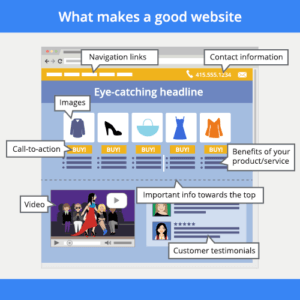Well, the answer to that is two-fold. Before you start spending money online, make sure you have brushed up your ‘owned’ online media such as your website and social media channels – they are unique to your brand and you control them. So the first part of this blog is about the groundwork.
Let’s take a closer look.
Optimize your Website for Search Engines
Your site should be well designed and load quickly. Ideally, you’ll also have some persuasive proof in the form of testimonials as well as fresh, useful content (blogs, videos, information, case studies, etc) that naturally include the keywords your prospects are looking for. Optimising your website, so it ranks a bit higher, doesn’t need to be complicated. Investing a bit of time each week to improve it will give you the best chance of being found by people looking for your products and services.

Image source: Google Adwords
Make sure you have all the information a visitor needs in order to buy from you and clear steps to guide visitors to the action you want them to take. Before you spend money bringing people to your website, think about what you want them to do when they get there.
Do you want them to buy something? To sign up for something? To book something?… Whatever it is, it should be front and centre, and compelling so that your valuable advertising dollar turns into sales or leads.
Add Google Analytics to your website so you can gather data on how many visitors you get, where they came from, what keywords they searched with, how long they stayed and much more. You don’t need to track everything but start with some straight forward metrics to help you to see the areas you need to improve, e.g. if your bounce rate on a page is high, you may need to add more compelling content.
Click here for more on optimising your website for search
Build engagement on your Social Media pages
Set up your business pages on Facebook, LinkedIn, Instagram, Twitter, etc (the right channels will depend on your business and your target audience).
Promote these pages across your marketing channels and encourage people to like and follow you. The more interaction with people on your page the more chance you’ll be seen by new eyes. So, make sure you post regularly and engage with customers. If you are adding content to your website, share it on your Facebook page, LinkedIn account or Instagram feed. Connect back to it in a tweet on Twitter by sharing key statements. By actively engaging with followers and fans you’ll increase the chance of being seen by more people.
Read more on growing your business on social media.
Over time, you should aim to spend a bit of time adding to these ‘owned’ platforms each week, whether it’s to add a blog or post a great image of the team or your products. The point is, that when you are ready to start spending money on advertising, it makes sense to have the organic (non-paid) work done. Advertising won’t improve your organic search ranking, so when it stops so does your visibility in search results . Plus, you’ll want to ensure that the hard work of getting someone to visit you is worth it with a compelling offer or strong value proposition.
Paying for online advertising
The groundwork above will give your campaign the best chance of success. Now you need to choose the right campaign type for your objectives.
There are a number of options to choose from. The best strategy will depend on your business, your products, who your customer is, and what you want them to do.
We’ll look at 4 main strategies for advertising online. (We’ll focus on email marketing another time).
Advertising on Search Engines
Search engine marketing (SEM) involves paying so that your listing appears on the search engine results page. These campaigns are text-based like a normal search entry and they are based on keywords. Keywords are the words or phrases that people type into the search field when they are looking for your products or services.
Search engine marketing is often called PPC because it works on a pay-per-click basis. On Google Adwords you can decide the maximum amount you want to pay for someone to click on your ad. Depending on the search volume at any given time, within the dates of your campaign, you may pay less than the amount you specify, but you can also be outbid. You can also set an average daily budget which allows for some days to be over but your total spend is controlled.
The way your ad performs is based on three factors:
– the amount you set to outbid the competition
– the time of the search but, importantly,
– the relevance of the keywords in your ad to what the person is searching for.
So it’s important to do your research into what keywords will work best for you. You can do your own online search and see what comes up. There are lots of tools you can use too, such as Moz.com. Make sure you track your performance over the campaign so you can see what’s working and what needs adjusting.
PPC is a great tool for reaching prospects who are already interested in your products and services – after all, they are already searching for you!
There is no minimum spend and you control the budget. However, it can be hard to compete against bigger budgets for popular search terms. A bit of research and testing on keywords is vital in order to find words and phrases that are less competitive but will still deliver a good click return.
Display Advertising
When you advertise on search, you appear in the search results, whereas display ads appear across the web in the form of banners, landing pages, and pop-ups or social ads. On Google’s display network, your ads can appear on news sites, blogs, Gmail and YouTube.
Search and display have different purposes. Whereas search ads appear for people who have ‘intent’, Display ads appear for people who are browsing a website or facebook, but they’re not actively looking for your products and services. In a nutshell, Search is better for conversion and Display is good for building awareness.
‘The average conversion rate across all industries on the display network is less than one percent but the display network works to create demand rather than answer demand like the search network’. Neil Patel
When you set up your display ad, you set a target audience based on location, interests, and demographics. The way you measure your return will be based on your advertising objectives.
- Cost per clicks (CPC) – each time someone clicks on your ad
- Cost per impressions (CPM) – each time your ad appears on a page that a person views
- Cost per conversion/acquisition (CPA) – each time the action you set was achieved, such as website visit, or appointment booked.
- Cost per video view.
Successful display ads encourage people to click on them. Display ads are used to direct people’s attention to your products and services and get them to do something, such as visit a page on your website. With increasing online advertising, we are all getting better at ignoring banners online, so your call to action message should be compelling and motivating. As with any online advertising make sure you actively manage your campaign by tracking your results and make changes to improve your cost of acquisition.
Remarketing
Remarketing is a form of display advertising that retargets people based on a product or service they’ve already viewed on your website.
Imagine someone visited your site to look at a product you sell or service you provide, but they didn’t buy. Remarketing targets these people, using cookie technology, when they are searching somewhere else on the internet. Your ad acts as a reminder to people to come back and buy from you. While it is a more assertive way to sell, done the right way, a remarketing ad will be seen as friendly and useful.
Remarketing campaigns have higher conversion rates than display ads simply because your prospective customer has already shown an interest in your products. This results in a lower cost per conversion.
Advertising on Social Media
It’s getting busy out there on Facebook, Twitter, LinkedIn, Instagram, etc, so putting some budget behind your messages on social media is a good idea to ensure you get seen.
With any advertising, first, decide what you want to achieve. Are you trying to raise awareness of a message, or post, build your followers or send traffic back to your website? Social Media ads are like display ads. Prospective customers are browsing things that interest them, rather than specifically looking for you.
Follow some simple rules for social :
Choose your channel – The channels that are right for your business will depend on your client base. Facebook is still the largest channel across a range of business sectors. Here’s a guide for advertising on Facebook. Think about where your clients come from and the social media channels they are likely to use. You can even ask clients or partners what channels they would expect you to be active on.
Define your target audience – Your target audience can be as broad or narrow as you like. Social Media advertising allows you to create very targeted campaigns. The more specific, the harder your budget will work.
Look-a-like audiences – Get more ideal customers with ‘look-a-like’ audiences, where you can reach audiences who share the same traits as the people who have already shown an interest in your business
Learn from your organic posts – Look at what is performing well in your unpaid social posts and tweets. This will guide you in creating an engaging ad.
Offer something of value – Make it worthwhile for your audience by providing something in return for their clicks, such as a great offer, a giveaway or a chance to win.
Track your performance – Decide whether you want engagement or impressions. Both have value depending on your advertising goals.
Test your ad – Use that immediate feedback you get on social to create a winning campaign. Start with smaller audiences to see what drives the most engagement.
Use BOMA to simplify your digital marketing – If you are an accountant or bookkeeper, BOMA gives you everything you need in one platform to create emails, organic social posts, and social ads.
ABOUT BOMA
BOMA is the marketing tool for Accountants and Bookkeepers.
BOMA gives you expertly written ready-to-share content and free images so you can create emails, newsletters and social posts in minutes. You can also create landing pages to capture new leads and run social advertising to promote your firm to new audiences.
Nothing comes close to BOMA in marketing your firm.
Find out how BOMA can help with your digital marketing.

